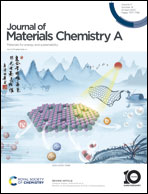Aramid-based aerogels for driving water evaporation through both photo-thermal and electro-thermal effects†
Abstract
Solar-powered interfacial water evaporation is thought as a promising strategy for clean water production to tackle global water pollution and scarcity. Nevertheless, the water evaporation rate under all-weather conditions still needs to be improved. Herein, we report an effective approach to develop an integrated photo-electro-thermal steam generation system consisting of aramid-based aerogels that illustrate high evaporation rate under 1 sun (1 kW m−2) illumination and can also carry out water evaporation effectively in low-light or dark environments. The porous aerogel evaporators with high conductivity are composed of aramid nanofibers (ANFs) and carbon nanotubes (CNTs) coated with in situ synthesized polypyrrole (PPy). Based on the photo-thermal effect and electro-thermal effect simultaneously, the evaporators ensure efficient all-weather water production. The evaporation rate of the photo-electro-thermal system reaches 4.71 kg m−2 h−1 with 1 sun radiation and an input voltage of 5 V, while the rate is 2.81 kg m−2 h−1 under only 1 sun illumination. Meanwhile, the system also shows promising potential in salt tolerance and dye wastewater treatment.



 Please wait while we load your content...
Please wait while we load your content...